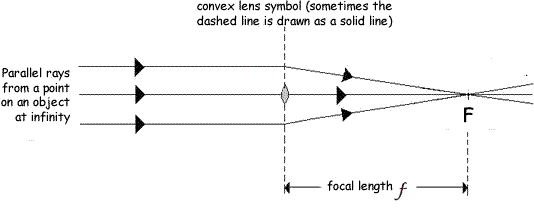Convex Lenses
The focal length of a lens is the distance between the pole of the lens and the focal point OR the perpendicular distance between the axis of the lens and the focal plane. The focal point or principal focus of a convex lens is the point through which rays of light travelling near t,o and parallel to, the principal axis pass after refraction by the lens. (The point all emerging rays pass through).
The image formed by a convex lensThe type of image you get from a convex lens depends upon the distance the lens is from the object it is viewing.
Lenses focus not only visible light but also infrared. A convex lens focuses the parallel rays of infrared light from the sun into a point focus. It can therefore set things alight! (See the newsreport on a £300,000 fire caused by a glass paperweight)
|
Follow me...
|


 The pole of the lens
is the centre of the lens. Rays drawn passing through this point in an optical diagram are
not diverted, they continue in a straight line.
The pole of the lens
is the centre of the lens. Rays drawn passing through this point in an optical diagram are
not diverted, they continue in a straight line. 





